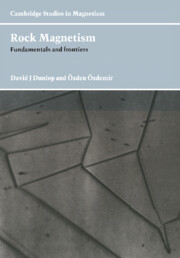Book contents
- Frontmatter
- Contents
- Preface
- Chapter 1 Magnetism in nature
- Chapter 2 Fundamentals of magnetism
- Chapter 3 Terrestrial magnetic minerals
- Chapter 4 Magnetostatic fields and energies
- Chapter 5 Elementary domain structures and hysteresis
- Chapter 6 Domain observations
- Chapter 7 Micromagnetic calculations
- Chapter 8 Single-domain thermoremanent magnetization
- Chapter 9 Multidomain thermoremanent magnetization
- Chapter 10 Viscous and thermoviscous magnetization
- Chapter 11 Isothermal magnetization and demagnetization
- Chapter 12 Pseudo-single-domain remanence
- Chapter 13 Crystallization remanent magnetization
- Chapter 14 Magnetism of igneous rocks and baked materials
- Chapter 15 Magnetism of sediments and sedimentary rocks
- Chapter 16 Magnetism of metamorphic rocks
- Chapter 17 Magnetism of extraterrestrial rocks
- References
- Index
Chapter 7 - Micromagnetic calculations
Published online by Cambridge University Press: 06 July 2010
- Frontmatter
- Contents
- Preface
- Chapter 1 Magnetism in nature
- Chapter 2 Fundamentals of magnetism
- Chapter 3 Terrestrial magnetic minerals
- Chapter 4 Magnetostatic fields and energies
- Chapter 5 Elementary domain structures and hysteresis
- Chapter 6 Domain observations
- Chapter 7 Micromagnetic calculations
- Chapter 8 Single-domain thermoremanent magnetization
- Chapter 9 Multidomain thermoremanent magnetization
- Chapter 10 Viscous and thermoviscous magnetization
- Chapter 11 Isothermal magnetization and demagnetization
- Chapter 12 Pseudo-single-domain remanence
- Chapter 13 Crystallization remanent magnetization
- Chapter 14 Magnetism of igneous rocks and baked materials
- Chapter 15 Magnetism of sediments and sedimentary rocks
- Chapter 16 Magnetism of metamorphic rocks
- Chapter 17 Magnetism of extraterrestrial rocks
- References
- Index
Summary
Introduction
The theory of domain structures in magnetite and titanomagnetite has made great strides in the last decade. Most earlier calculations used Kittel or Amar models like those of §5.4. These were deterministic; no interesting and novel structures could emerge. Block-like walls and domains without internal structure were imposed in advance. Only their numbers and widths were adjustable. We will review some of these calculations in §7.2.
About the mid-1980's, less constrained micromagnetic calculations (Brown, 1963a) were introduced in rock magnetism. In micromagnetism, model crystals are divided into cells and the magnetization direction of each cell is varied independently until an overall structure emerges that minimizes the total energy. Most such structures are local energy minimum (LEM) states rather than the global energy minimum (GEM) state. That is, the equilibrium number of domains has usually not been found. However, at least domain structure can be expected to emerge in a natural way instead of being imposed at the outset. Fine structures within domains and domain walls also appear without forcing.
In model magnetite crystals larger than ≈0.5 μm, the calculations do converge on structures resembling classic domains. Closure domains and finer structures such as vortices feature in the solutions. In smaller grains, the fine structures fill much of the particle. Domains as such are barely recognizable until the SD range (< 0.1 μm) is reached. These structures are described in §7.3–7.5. Changes in particular LEM states or families of states with changes in applied field H0, grain volume V, and temperature T are the subject of §7.6–7.8.
- Type
- Chapter
- Information
- Rock MagnetismFundamentals and Frontiers, pp. 171 - 200Publisher: Cambridge University PressPrint publication year: 1997



